Briefly: In our opinion, full (150% of the regular full position) speculative short positions in gold, silver and mining stocks are justified from the risk/reward perspective at the moment of publishing this alert.
Gold and silver turned around during yesterday’s session and the HUI Index rallied almost 3%. Is it high time to take profits off the able and switch from short positions to long ones based on the above?
In short, it doesn’t seem to be the case. Let’s see why (chart courtesy of http://stockcharts.com).
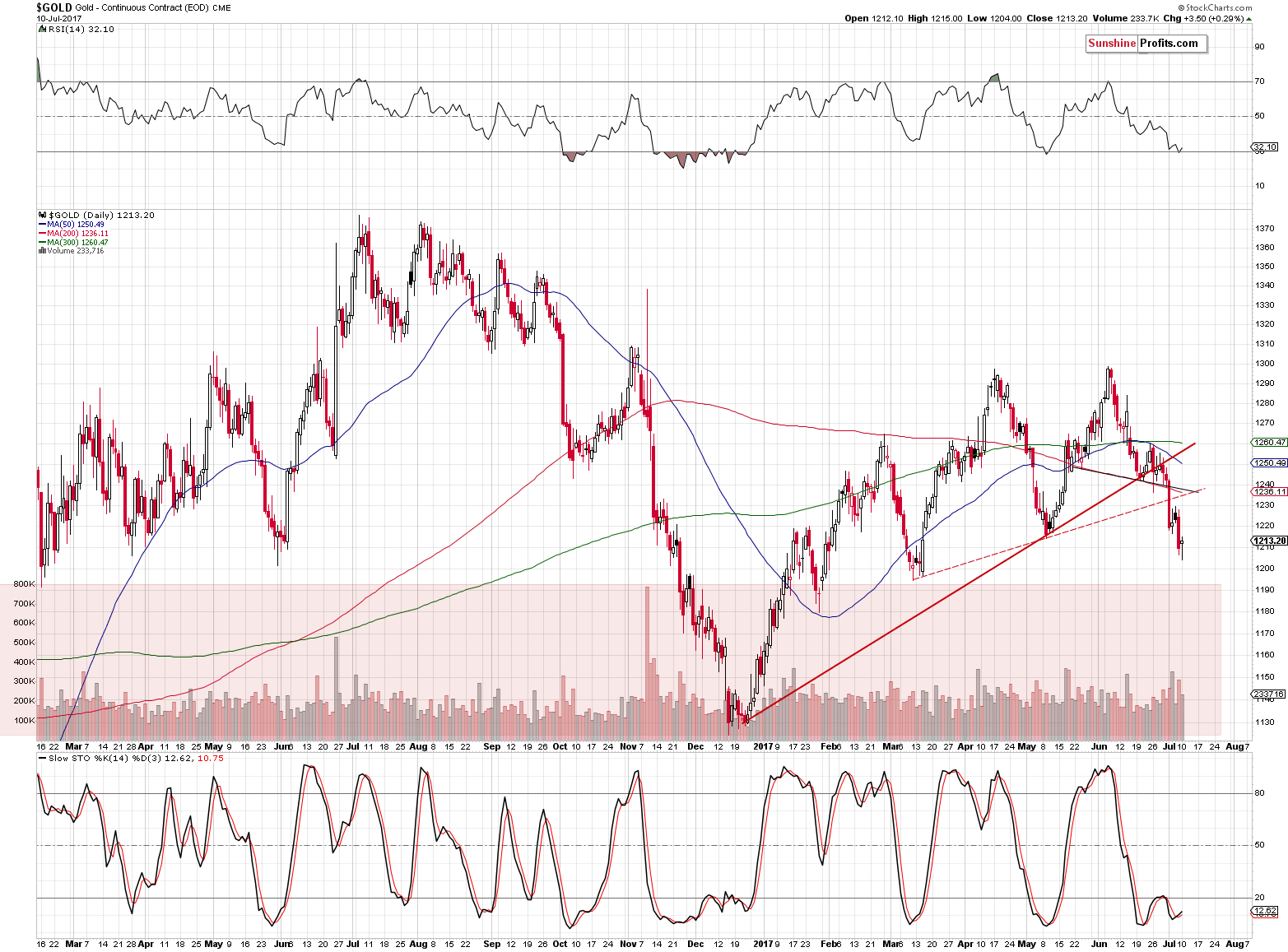
The reversal in gold was relatively small and it was accompanied by relatively small volume. In the case of the reversals, big volume is an important sign as it shows that the buying power overwhelms sellers. In the case of relatively small volume, it appears more likely that gold bounced and didn’t manage to decline before the end of the session. The closing price is another factor that confirms the former scenario – gold closed below its May low (in terms of the closing prices).
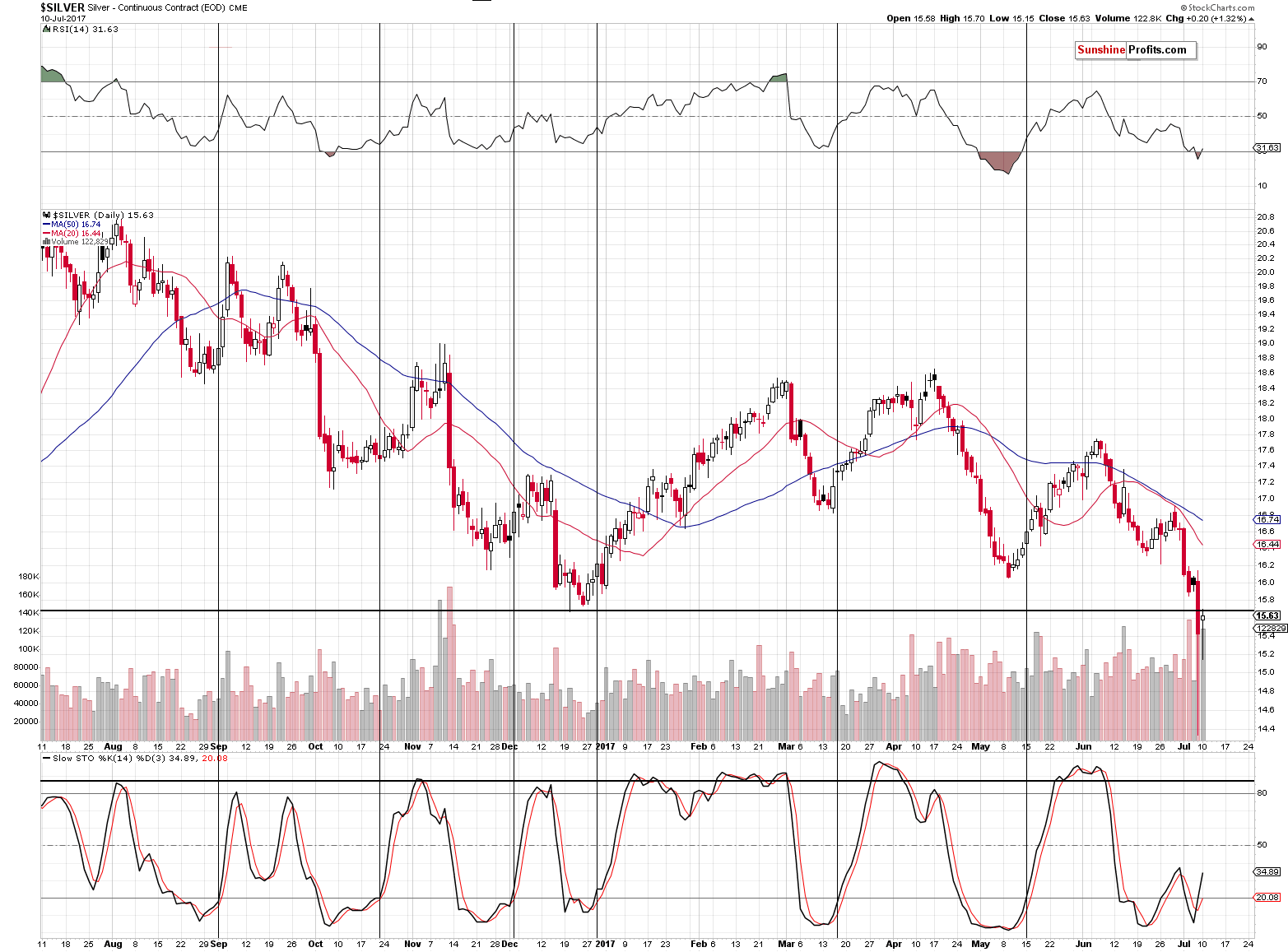
The volume in silver was relatively bigger, but the closing price level also suggests that the rally was more of a bounce than of a true reversal – the white metal closed the session not only below the May low, but also below its December 2016 low. Yesterday’s action still appears to be a verification of the breakdown, especially that silver moved lower in today’s pre-market trading.
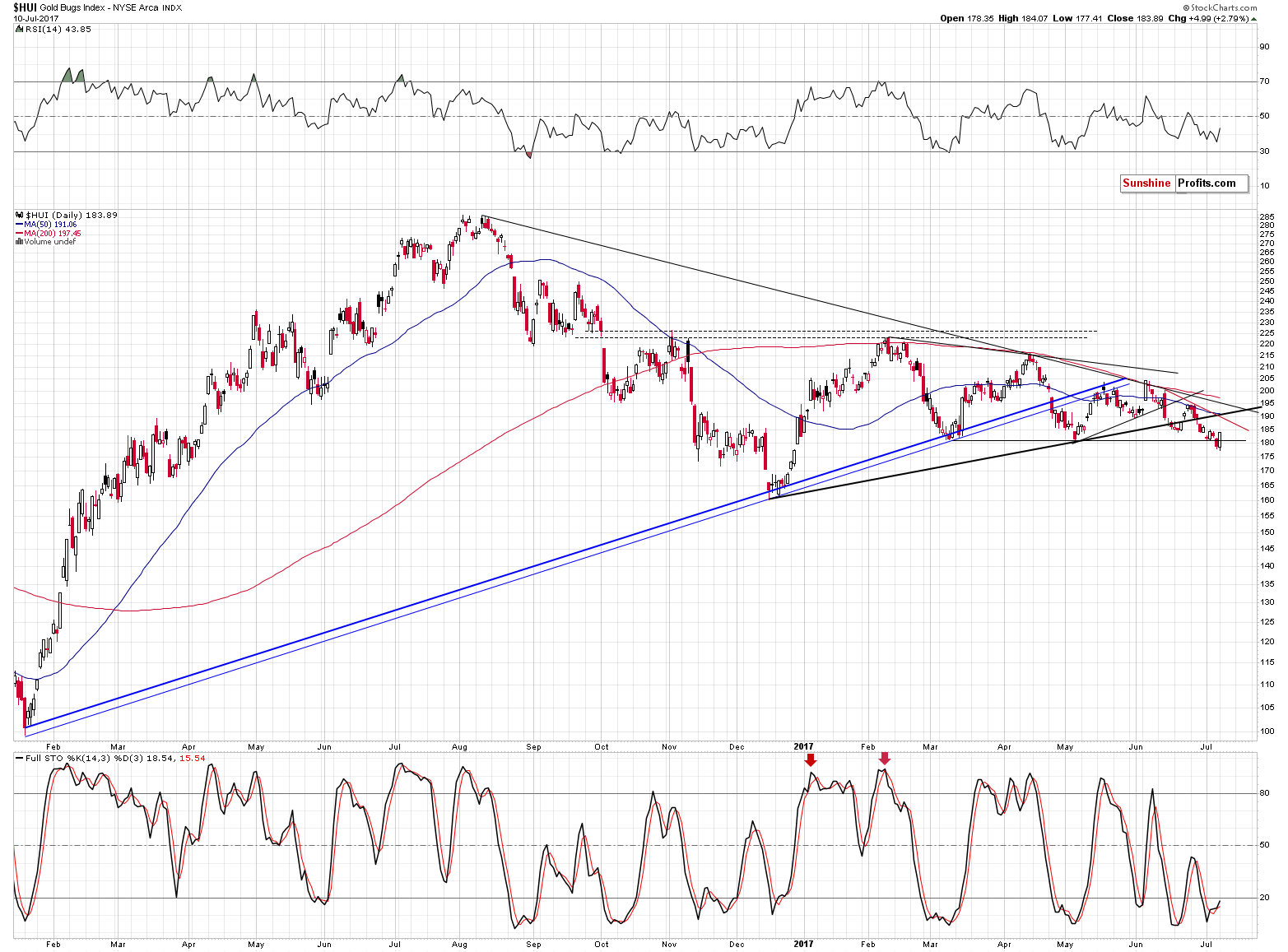
Gold stocks moved higher yesterday and the session’s candlestick is quite visibly bullish. Is there anything not to like about this “bullish” signal? A couple of things – let’s start with what’s visible on the above chart and that is that the possible upside target is very limited – the declining, rising and short-term declining resistance lines are very close, which would likely keep the rally in check, if one was to follow.
The other thing is that it was just one session of strength and one swallow doesn’t necessarily make a summer. Surely, one could argue that in the case of an invalidation of a breakdown, one session is enough to make a difference, but let’s keep in mind that the previous low is not the only thing that gold stocks broke below. Miners moved below the rising support line based on the previous important lows and this line was not invalidated and miners did not even move close to it.
Most importantly, however, we know how the HUI Index performed during the 2012-2013 decline.
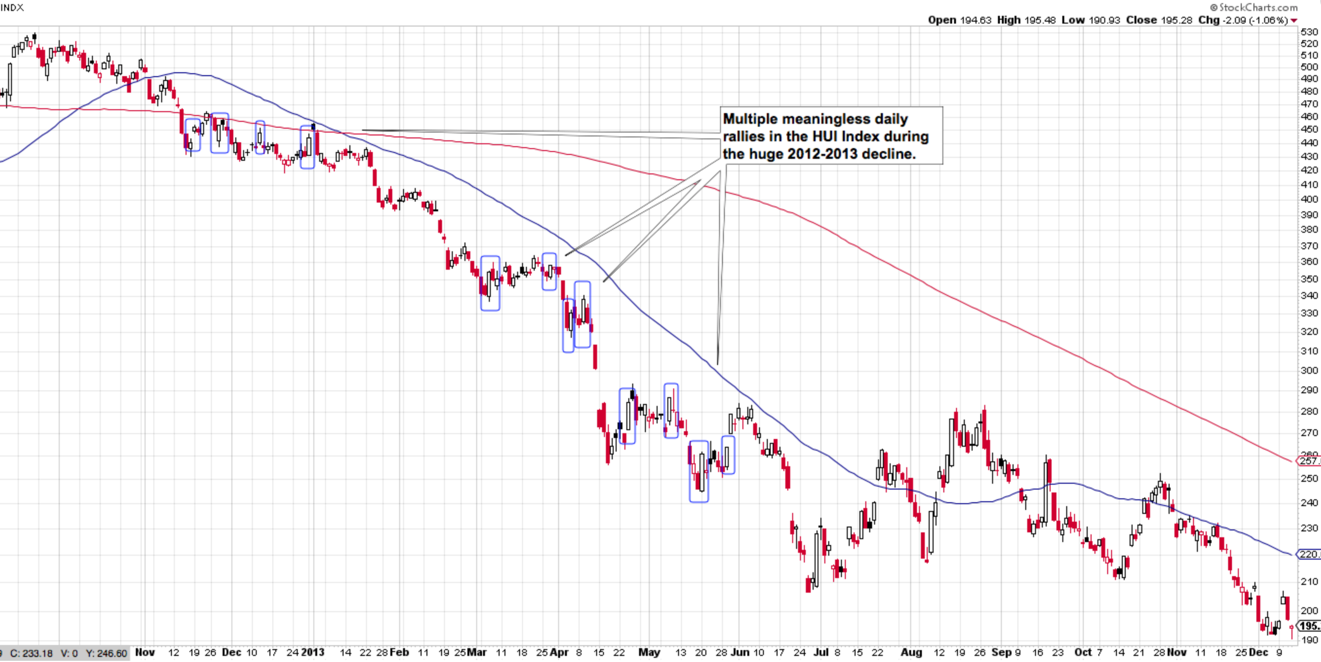
It turns out that there were multiple daily rallies within the decline. Which one of them was worth taking action on? None of them. It was better to wait out the following small corrections and profit on the huge downtrend.
Naturally, one could say that the current decline is not like the 2013 decline, but last week’s action in silver suggests otherwise.
Finally, we saw an additional bearish signal recently.
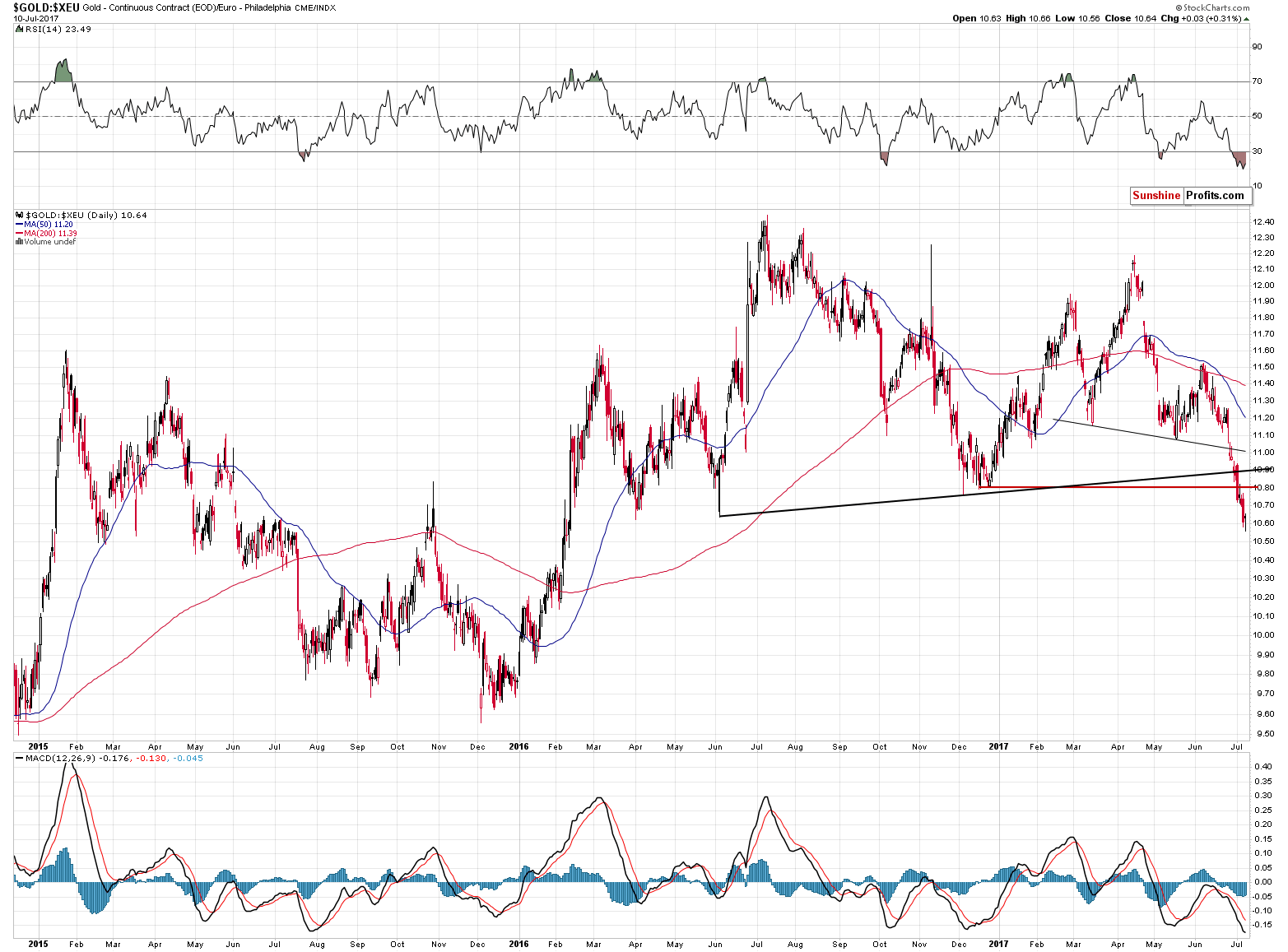
The price of gold in the euro broke not only below the neck level of this year’s head-and-shoulders pattern, but it also below the big, 2016-today pattern based on key 2016 lows. The implications for the following weeks are bearish – gold is likely to decline even if the USD doesn’t show strength (and the latter is likely anyway). However, the above chart also says that we could see a temporary move back to the mentioned levels that were recently broken. Should that be the case, it wouldn’t make the outlook bullish.
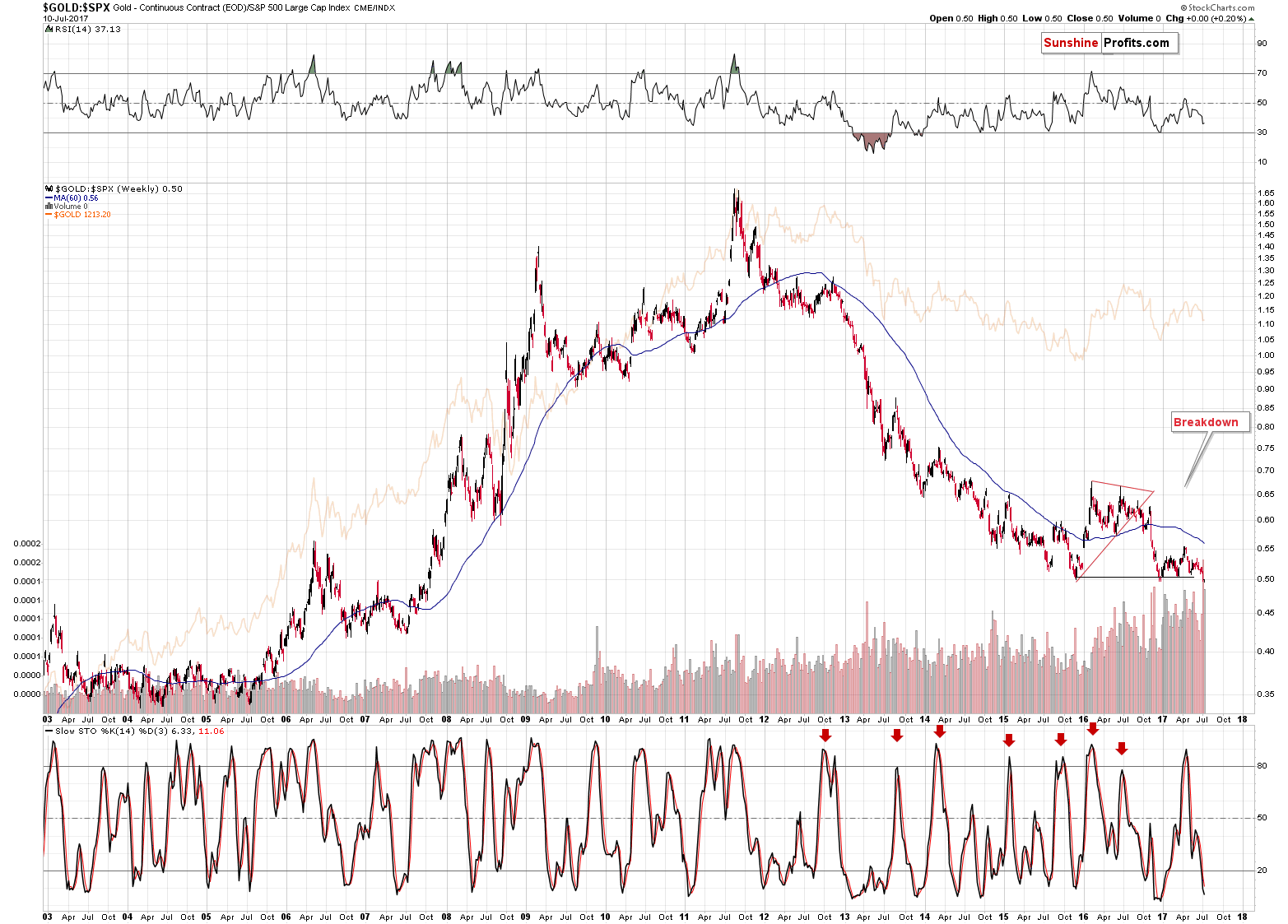
Finally, please note that the gold’s ratio to the general stock market is moving below its previous lows. The breakdown is not huge, but the ratio did move below the 2015 and 2016 lows. If the ratio closes the week visibly below them, we will have a major breakdown and a huge decline will become even more likely for the following weeks and months.
Summing up, the outlook for the precious metals market is very bearish and it appears that the decline will take on a much more visible form in the coming weeks, even though a small (!) upswing in the next few days would not surprise us. While it does present an excellent trading opportunity (and the previously-entered short positions are already profitable), let’s keep in mind that the biggest gains in the coming years will be made with the investment capital and the upcoming decline will very likely provide us with an epic buying opportunity – that’s something worth preparing for.
As always, we will keep you – our subscribers – informed.
To summarize:
Trading capital (supplementary part of the portfolio; our opinion): ): Short positions (150% of the full position) in gold, silver and mining stocks are justified from the risk/reward perspective with the following stop-loss orders and initial target price levels / profit-take orders:
- Gold: exit-profit-take level: $1,063; stop-loss: $1,317; initial target price for the DGLD ETN: $81.88; stop-loss for the DGLD ETN $44.57
- Silver: initial target price: $13.12; stop-loss: $19.22; initial target price for the DSLV ETN: $46.18; stop-loss for the DSLV ETN $17.93
- Mining stocks (price levels for the GDX ETF): initial target price: $9.34; stop-loss: $26.34; initial target price for the DUST ETF: $143.56; stop-loss for the DUST ETF $21.37
In case one wants to bet on junior mining stocks' prices (we do not suggest doing so – we think senior mining stocks are more predictable in the case of short-term trades – if one wants to do it anyway, we provide the details), here are the stop-loss details and initial target prices:
- GDXJ ETF: initial target price: $14.13; stop-loss: $45.31
- JDST ETF: initial target price: $417.04; stop-loss: $43.12
Long-term capital (core part of the portfolio; our opinion): No positions (in other words: cash)
Insurance capital (core part of the portfolio; our opinion): Full position
Important Details for New Subscribers
Whether you already subscribed or not, we encourage you to find out how to make the most of our alerts and read our replies to the most common alert-and-gold-trading-related-questions.
Please note that the in the trading section we describe the situation for the day that the alert is posted. In other words, it we are writing about a speculative position, it means that it is up-to-date on the day it was posted. We are also featuring the initial target prices, so that you can decide whether keeping a position on a given day is something that is in tune with your approach (some moves are too small for medium-term traders and some might appear too big for day-traders).
Plus, you might want to read why our stop-loss orders are usually relatively far from the current price.
Please note that a full position doesn’t mean using all of the capital for a given trade. You will find details on our thoughts on gold portfolio structuring in the Key Insights section on our website.
As a reminder – “initial target price” means exactly that – an “initial” one, it’s not a price level at which we suggest closing positions. If this becomes the case (like it did in the previous trade) we will refer to these levels as levels of exit orders (exactly as we’ve done previously). Stop-loss levels, however, are naturally not “initial”, but something that, in our opinion, might be entered as an order.
Since it is impossible to synchronize target prices and stop-loss levels for all the ETFs and ETNs with the main markets that we provide these levels for (gold, silver and mining stocks – the GDX ETF), the stop-loss levels and target prices for other ETNs and ETF (among other: UGLD, DGLD, USLV, DSLV, NUGT, DUST, JNUG, JDST) are provided as supplementary, and not as “final”. This means that if a stop-loss or a target level is reached for any of the “additional instruments” (DGLD for instance), but not for the “main instrument” (gold in this case), we will view positions in both gold and DGLD as still open and the stop-loss for DGLD would have to be moved lower. On the other hand, if gold moves to a stop-loss level but DGLD doesn’t, then we will view both positions (in gold and DGLD) as closed. In other words, since it’s not possible to be 100% certain that each related instrument moves to a given level when the underlying instrument does, we can’t provide levels that would be binding. The levels that we do provide are our best estimate of the levels that will correspond to the levels in the underlying assets, but it will be the underlying assets that one will need to focus on regarding the signs pointing to closing a given position or keeping it open. We might adjust the levels in the “additional instruments” without adjusting the levels in the “main instruments”, which will simply mean that we have improved our estimation of these levels, not that we changed our outlook on the markets. We are already working on a tool that would update these levels on a daily basis for the most popular ETFs, ETNs and individual mining stocks.
Our preferred ways to invest in and to trade gold along with the reasoning can be found in the how to buy gold section. Additionally, our preferred ETFs and ETNs can be found in our Gold & Silver ETF Ranking.
As a reminder, Gold & Silver Trading Alerts are posted before or on each trading day (we usually post them before the opening bell, but we don't promise doing that each day). If there's anything urgent, we will send you an additional small alert before posting the main one.
=====
Latest Free Trading Alerts:
Last week, silver plunged over 10 percent in less than a minute. What does it mean for the precious metals market?
=====
Hand-picked precious-metals-related links:
CITI WARNS: Gold is setting up for a drop
Eldorado finishes Integra Gold acquisition, expands operations in Canada
=====
In other news:
IMF sees trouble ahead for emerging Europe
Clearing Firms Simulate Lehman-Like Default During Brexit Chaos
Central banks are ending policies like QE – but they'll be back
Bonds and emerging market currencies' selloff resumes
Mt Gox CEO denies embezzling millions of dollars of bitcoins
Mining jobs among the ones artificial intelligence will take over first
=====
Thank you.
Sincerely,
Przemyslaw Radomski, CFA
Founder, Editor-in-chief, Gold & Silver Fund Manager
Gold & Silver Trading Alerts
Forex Trading Alerts
Oil Investment Updates
Oil Trading Alerts



